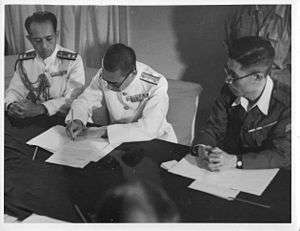Operation Zipper
| Operation Zipper | |||||||
|---|---|---|---|---|---|---|---|
| Part of the Second World War | |||||||
 Rear Admiral Jisaku Uozumi signs the surrender document aboard the HMS Nelson. 2 September 1945. He fainted shortly afterwards and was rushed to hospital. Note the Distinguished Service Cross ribbon on Uozumi's uniform, which he had earned as Britain's ally in World War I.[1] | |||||||
| |||||||
| Belligerents | |||||||
| Commanders and leaders | |||||||
|
|
| ||||||
| Strength | |||||||
|
42,651 infantry[4] 2 escort carriers 1 battleship 1 light cruiser 3 destroyers 3 troopships[5] | 26,000 infantry[6] | ||||||
| Casualties and losses | |||||||
| None | 26,000 captured | ||||||
During World War II, Operation Zipper was a British plan to capture either Port Swettenham or Port Dickson, Malaya as staging areas for the recapture of Singapore in Operation Mailfist. However, due to the end of the war in the Pacific, it was never fully executed. Some of the proposed landings on Penang went ahead as planned to probe Japanese intentions, encountering no resistance.[7] The planned deception for this attack was called Operation Slippery, whilst a small Special Operations Executive team led by Tun Ibrahim Ismail which landed in October 1944 managed to convince the Japanese that the landings were to be on the Isthmus of Kra, 650 miles (1,050 km) to the north.[8]
Operation Tiderace was instead put into action following the surrender of Japan. The Allied fleet departed Rangoon on 27 August 1945, as part of Vice Admiral Harold Walker's force. The fleet sailing for Penang was designated 'Task Force 11',[9] and consisted of the battleship HMS Nelson, escort carriers HMS Attacker[10] and HMS Hunter,[11] light cruiser HMS Ceylon, destroyers HMS Paladin and HMS Petard and two Landing Ship, Infantry.[9] They arrived in Penang on 28 August. HMS Nelson was the flagship of the fleet, and the articles of surrender were signed aboard the battleship on 2 September.
With the Japanese surrender, troops of the 25th Indian Division deployed to Malaya, Walker's fleet then sailed to Singapore to join up with the main convoy.
References
- ↑ "After some delay, and a failure to attend an earlier meeting, the Japanese local commander, Rear Admiral Jisaku Uzumi, came aboard HMS Nelson on the evening of 2 September, wearing the DSC he had earned as Britain's ally in the 1914-18 war, and surrendered the garrison. He fainted and was rushed to hospital; the military policemen who carried him there took his sword as a souvenir." Bayly & Harper, page 49
- ↑ Operation Zipper: The Invasion of Malaya, August 1945
- ↑ Sir Harold Thomas Coulthard Walker, RN
- ↑ 46 Indian Beach Group, Morib
- ↑ HMS NELSON - Nelson-class 16in gun Battleship
- ↑ "The real Japanese surrender" (PDF). The Sunday Times. 2005-09-04. Retrieved 2009-12-09.
- ↑ Forgotten wars: Freedom and Revolution in Southeast Asia
- ↑ "Obituary:Tun Ibrahim Ismail". Daily Telegraph. 26 Jan 2011. Retrieved 30 January 2011.
- 1 2 JAPANESE SIGN THE SURRENDER OF PENANG ABOARD HMS NELSON (3/9/1945), Colonial Film, 3 Sep 1945, retrieved 12 Jun 2011
- ↑ H.M.S. Attacker, royalnavyresearcharchive.org.uk
- ↑ H.M.S. Hunter, royalnavyresearcharchive.org.uk
Bibliography
- Bose, Romen, "The End of the War: Singapore's Liberation and the aftermath of the Second World War", Marshall Cavendish, Singapore, 2005
- Christopher Bayly & Tim Harper, "Forgotten Wars: Freedom And Revolution in Southeast Asia", Penguin Group, United Kingdom, 2006, ISBN 978-0-674-02153-2, ISBN 0-674-02153-3